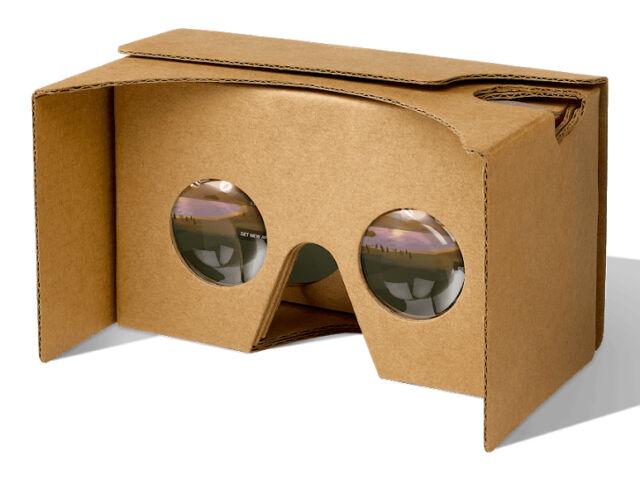reader comments
151
with 105 posters participating
Share this story
Share on Facebook
Share on Twitter
Share on Reddit
The Cardboard VR Viewer.
Your phone went in the front and powered everything.
A phone in VR mode.
The Daydream VR headset, a fancier version of Google Cardboard with a head strap and a controller. It lasted from 2016 to 2019.
The Lenovo Mirage Solo was an even more upgraded Google headset. All the phone parts were a permanent part of the headset, and it came with 6-DoF head tracking.
Android's VR homescreen.
The VR Google Play Store.
Google's Tilt Brush let you paint in 3D.
Google's last surviving VR product is dead. Today the company stopped selling the Google Cardboard VR viewer on the Google Store, the last move in a long wind-down of Google's once-ambitious VR efforts. The message on the
Google Store
, which was first spotted by
Android Police
, reads, "We are no longer selling Google Cardboard on the Google Store."
Google Cardboard was
a surprise hit
at Google I/O 2015 and moved the entry point for VR lower than anyone had imagined previously. The device was a literal piece of cardboard, shaped like a VR headset, with special plastic lenses. Google built a Cardboard app for Android and iOS, which would let any suitably high-end phone power the headset. The landscape display split into left and right views for your eyes, the phone hardware rendered a VR game, and the accelerometers did 3-DoF (degrees of freedom) head tracking. There was even a cardboard action button on the handset that would boop the touchscreen with a capacitive pad, so you could aim with your head and select options in a VR environment. Since the product was just cardboard and plastic lenses with no electronics whatsoever, Google sold the headset for just $20.
Advertisement
After cardboard, Google started to scale up its VR ambitions. In 2016, Google also launched an upscaled version of Google Cardboard, the
Google Daydream VR headset.
This was a plastic and cloth version of a phone-powered VR headset, with the key improvements of a head strap and a small controller, for $80.
Next, Google started to pile on software support. VR support also was
built into
Android 7 Nougat in 2016, allowing Google to make latency-reducing graphics pipeline improvements in the core OS. Google started certifying devices for enhanced "Daydream" support, laying out best hardware and software practices for VR. Android got a VR home screen and added a special notification style so apps could still alert you in the 3D VR interface. A VR version of the Play Store let users download the latest VR experiences in 3D. VR support came to YouTube and Google Street View, and together with Mozilla, the Chrome team launched WebVR. Google's best app was Tilt Brush,
a killer piece
of VR painting software.
In 2018, Google even roped OEMs into making
standalone Daydream VR hardware
, so instead of being powered by a phone, Android and all the usual phone bits wer
e integrated into a standalone VR headset. The first one announced was theLenovo Mirage Solo
.
Google’s VR legacy
As in

many other areas
, Google was very enthusiastic about VR for a few years, and then the company quickly lost interest when it didn't see immediate success. The VR shutdown started in 2019, when Google omitted Daydream support from the Pixel 4
and killed
the Daydream VR headset line. Google put out a VR post-mortem statement saying there was resistance to using a phone for VR, which cut off access to all your apps, and that the company hadn't seen "the broad consumer or developer adoption we had hoped." It was also around this time that Google
open sourced
the Cardboard project. VR support in Android was
stripped out
of consumer phones with 2020's release of Android 11, and Google
quit Tilt Brush development
in January 2021, choosing to open source the app under Apache 2.0.
Advertisement
Google kills product
Google kills its augmented reality “Measure” app
Google is killing “Google Play Movies & TV” on smart TVs
Google is killing the Google Shopping app
Google’s VR dreams are dead: Google Cardboard is no longer for sale
Ex-Stadia developers dish on Google’s mismanagement and poor communication
View more stories
Google might have quit VR, but Cardboard and Android's VR legacy live on. Android should still stick around for a long while in VR, even if it's not officially sanctioned by Google. Oculus and Samsung originally teamed up on the
Gear VR
, a fancy, plastic VR viewer that was powered by Samsung's Android phone line. While Samsung has
quit phone VR
, too, all of Oculus' standalone
"Quest" VR
headsets still
run Android.
Standalone VR headsets are always powered by ARM chips and other off-the-shelf smartphone parts, so Android—however, forked or stripped-down you want to make it—will be a top pick to power this smartphone-adjacent hardware. It already has all the hardware support and APIs you could want, so why re-invent the wheel?
Three years after Cardboard, Nintendo took Google's "cheap cardboard accessory" idea and ran with it, creating the
Nintendo Labo
products. Labo packaged Nintendo Switch software with a boatload of pre-cut, printed cardboard sheets, which could be assembled into all sorts of cheap peripherals like
a cardboard piano
, or
a robot suit
. The
Labo VR kit
was an exact Google Cardboard copy: a cardboard VR headset used the Nintendo Switch as the display, letting you view Nintendo's worlds in 3D.
Google's VR division has turned its attention (at least for a while) to AR instead of VR. Google's ARCore framework lets developers make augmented reality apps for Android and iOS, and the company
regularly ships
AR improvements on Android phones. With Apple
reportedly working
on a VR headset, though, you've got to wonder how long Google's fickle product direction will be able to stay away from VR.




